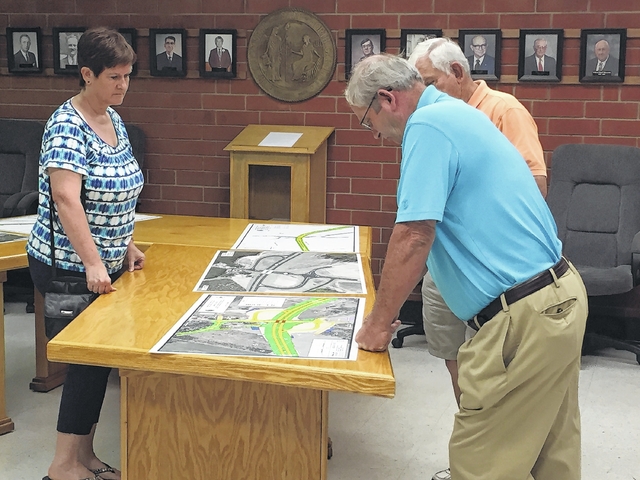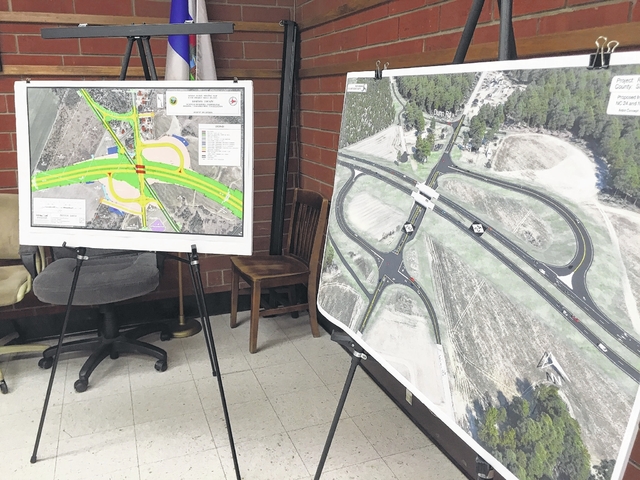North Carolina Department of Transportation officials hosted an informal public meeting Wednesday afternoon, allowing residents of the Roseboro and Salemburg areas a chance to share their ideas, thoughts and suggestions concerning the overpass at the intersection of N.C. 24 and N.C. 242.
A year ago, those same residents went before officials from the DOT and asked that plans for an at-grade intersection at the new N.C. 24 and N.C. 242 to be reconsidered and a signal light be erected in its place. Those pleas and cries were heard, and the state department announced that in order to achieve a free flow of traffic at the intersection, an interstate-style interchange would be constructed.
“After a year of planning, the interchange is on the drawing board,” Roseboro mayor Alice Butler shared prior to the open house meeting.
Before residents were invited to come in, the DOT sat down with local government officials, as well as representatives and consultants from CDM Smith and Stantec, to review the proposed plan for the N.C. 24 Roseboro Bypass Construction Project.
The N.C. 24 project is currently under construction and slated for completion in September 2017. The change in the plan design has not affected the overall completion date. This project extends nearly 40 miles from Interstate 95 to Warsaw and affects Cumberland, Sampson and Duplin counties.
“The purpose of this interchange project is to improve traffic capacity, improve mobility and inter-connectivity of the surrounding road network, and reduce congestion,” Brian Yamamoto, project engineer with DOT, said.
According to Yamamoto, the proposed transportation infrastructure improvements include N.C. 242 grade separation over N.C. 24 with full access ramps in the northeast and southwest quadrants, eliminating the original proposed median access controlled at-grade intersection and full access and movement for state road 1300, North Street.
“This interchange will allow traffic to continue with uninterrupted access on 242 and improve the function of 24, which we have always wanted to do,” Yamamoto explained.
The new interchange will not require the state department to take any additional residential or commercial property in the area. There will only be vacant property affected by the change. The interchange additionally impacts .04 acres of wetlands, 13.19 acres of right of way and 1.48 acres of easements.
“This change will not change or delay completion,” Yamamoto said.
Wednesday’s open-house style meeting allowed those residents who are fully impacted by the interchange to come in and talk with department officials and offer any ideas or address any concerns.
“We truly see this change as a positive,” Yamamoto said. “The only way this could be a negative for someone is if they were losing residential or commercial property, and they aren’t.”
This new approach, DOT officials stated, will improve safety at the interchange location by replacing the proposed at-grade intersection that would have included traffic signals and stop signs to an interchange with free-style movement through the area, aimed at eliminating potential intersection crashes, and reducing congestion.
“To say the least, we are extremely pleased that the process worked,” Butler stated during a previous meeting. “Not only did our public officials give us an opportunity to be heard, but they responded. This will make the roads much safer for all who travel them. That was the ultimate concern — safety.”
N.C. 242 and N.C. 24 are both heavily traveled by transfer trucks. With Lakewood High School being just down the road from the interchange, residents were concerned for the safety of those students on buses and driving cars when traveling to and from school. If the at-grade intersection remained, parents and community members were concerned about the safety of students making turns.
“With N.C. 242 crossing over the N.C. 24 bypass, travel on these highways will be much safer for everyone (including) students, parents, teachers, farmers, bus drivers and truck drivers,” Butler said. “I am thrilled for the businesses, the buses and the overall safety of our community. This is the best option for the Roseboro and Salemburg communities.”
The $150 million N.C. 24 widening project changes the highway from two to four lanes over 27.182 miles between Maxwell Road in Cumberland County and U.S. 421/701 in Clinton. Work on the project started in July 2013 and is expected to wrap up in fall 2017. The change in the intersection will add an additional $2.5 million to the project.
Once completed, it will yield important safety benefits as well as provide greater connectivity between I-95 and I-40, DOT officials have said. The wider, safer road will also allow for larger commercial vehicles transporting cargo to and from the port in Wilmington to other sections of the state.


